Focal Mechanisms and Stress Field Characteristics of Microearthquakes in Baihetan Reservoir in the Downstream Area of Jinsha River
Abstract
:1. Introduction
2. Tectonic Background and Data
3. Method and Parameter Setting
4. Results and Analyses
4.1. Seismicity in the Reservoir Area
4.2. Focal Mechanism Solution
4.3. Stress Field
5. Conclusions
- (1)
- The distribution of pre-impoundment earthquakes in the reservoir area is mainly controlled by regional stress fields and faults. As the impoundment proceeds, the number of earthquakes increases significantly, especially small and microearthquakes. These earthquakes are clustered in Hulukou town and dominantly distributed along the north-northeastern Sikaijiaoji and Jinsha Rivers, the north-northwestern Zemuhe fault and Heishuihe tributary, and the south-southeastern Xiaojiang fault and Jinsha River, showing an overall “Y-shaped” pattern. In addition, the number of earthquakes in the Ludian aftershock zone enormously decreases;
- (2)
- After the impoundment, microearthquakes are observed in three reservoir sections, where normal fault-induced earthquakes are the most predominant. The dominant distribution of the fracture planes obtained from the inversion of the mechanism solution is consistent with the direction of the local main structures or fault zones, indicating that they are controlled by the local tectonic environment;
- (3)
- In the three reservoir sections with post-impoundment microearthquakes, the azimuth angle and dip angle of the maximum tensile stress axis are consistent; both are in the south-southwestern direction and nearly horizontal. whereas the maximum primary compressive stress axes are nearly vertical, suggesting the effect of post-impoundment vertical compressive stress and horizontal tensile stress fields in the areas with microearthquakes;
- (4)
- Pre-existing fissures and structures in the reservoir area are the prerequisites for inducing earthquakes, and the water level change is an essential external factor that influences earthquake occurrence;
- (5)
- The occurrence of earthquakes is closely related to the drastic increase in impoundment loading and the water-level-change-induced elastic stress on the side slope, joints, fissures, and other small-scale structures. Such features accord well with the features observed in the pre-impoundment period of the downstream area of the Xiluodu Reservoir. Due to the continuous influence of reservoir impoundment on the surrounding geological environment, and considering complex regional tectonic structures and the occurrence of strong historical earthquakes, it is necessary to pay close attention to the possibility of moderate-to-strong earthquakes in the reservoir area in the future.
Author Contributions
Funding
Data Availability Statement
Acknowledgments
Conflicts of Interest
References
- Cheng, W. The reservoir induced earthquake problems in the high intensity areas. Recent Dev. World Seismol. 2013, 4, 10–18. (In Chinese) [Google Scholar]
- Diao, G.; Wang, R.; Feng, X.; Wang, X.; Feng, Z.; Zhang, H.; Chen, W.; Li, Y.; Wang, L. Analysis of the focal mechanism after impoundment in the head area of Xiluodu Reservoir. Seismol. Geol. 2014, 36, 644–657. (In Chinese) [Google Scholar]
- Guo, W.; Zhao, C.; Zuo, K.; Zhao, C. Characteristics of seismicity before and after impoundment of Baihetan dam in the lower reaches of Jinsha River. Chin. J. Geophys. 2022, 65, 4569–4671. (In Chinese) [Google Scholar]
- Wang, M.; Yang, M.; Hu, Y.; Li, Z.; Chen, Y.; Jin, Y.; Feng, R. A preliminary study on the focal mechanism of the Xinfengjiang Reservoir earthquake and its causes. Sci. China 2002, 19, 85–97. (In Chinese) [Google Scholar]
- He, L.; Sun, X.; Yang, H.; Qin, J.; Shen, Y.; Ye, X. Upper Crustal Structure and Earthquake Mechanism in the Xinfengjiang Water Reservoir, Guangdong. China. J. Geophys. Res. Solid Earth 2018, 123, 3799–3813. [Google Scholar] [CrossRef]
- Yao, Y.; Wang, Q.; Liao, W.; Zhang, L.; Chen, J.; Li, J.; Yuan, L.; Zhao, Y. Influences of the Three Gorges Project on seismic activities in the reservoir area. Sci. Bull. 2017, 62, 1089–1098. [Google Scholar] [CrossRef] [PubMed]
- Chen, H.; Zhao, C.; Xiu, J.; Chen, Z. Focal mechanism and stress field characteristics of reservoir induced earthquakes in Longtan reservoir area. Seismol. Geol. 2009, 31, 686–698. (In Chinese) [Google Scholar]
- Yan, C.; Zhou, B.; Lu, L.; Sun, W.; Wen, X. Focal mechanism of small and medium earthquakes in Longtan reservoir area after impoundment. Chin. J. Geophys. 2015, 58, 4207–4222. (In Chinese) [Google Scholar]
- Duan, M.; Zhao, C. Characteristics of focal mechanism in the downstream reservoir area of Jinsha River. Seismol. Geol. 2019, 41, 1155–1171. (In Chinese) [Google Scholar]
- Chrysanidis, T.; Mousama, D.; Tzatzo, E.; Alamanis, N.; Zachos, D. Study of the Effect of a Seismic Zone to the Construction Cost of a Five-Story Reinforced Concrete Building. Sustainability 2022, 14, 10076. [Google Scholar] [CrossRef]
- Ren, J. Geotectonic Evolution of China, 1st ed.; Science Press: Beijing, China, 1980; pp. 1–116. (In Chinese) [Google Scholar]
- Li, J.; Zhang, H.; Kuleli, H.; Toksoz, M. Focal mechanism determination using high-frequency waveform matching and its application to small magnitude induced earthquakes. Geophys. J. Int. 2011, 184, 1261–1274. [Google Scholar] [CrossRef]
- Li, J.; Kuleli, H.; Zhang, H.; Toksoz, M. Focal mechanism determination of induced microearthquakes in an oil field using full waveforms from shallow and deep seismic networks. Geophysics 2011, 76, 87–101. [Google Scholar] [CrossRef]
- Bouchon, M. A simple method to calculate Green’s functions for elastic layered media. Bull. Seismol. Soc. Am. 1981, 71, 959–971. [Google Scholar] [CrossRef]
- Bouchon, M. A Review of the Discrete Wavenumber Method. Pure Appl. Geophys. 2003, 160, 445–465. [Google Scholar] [CrossRef]
- Wang, C.; Mooney, W.D.; Wang, X.; Wu, J.; Lou, H.; Wang, F. Three-dimensional velocity structure of crust and upper mantle in Sichuan-Yunnan region. Acta Seismol. Sin. 2002, 24, 1–16. (In Chinese) [Google Scholar] [CrossRef]
- Zoback, M.L. First- and second-order patterns of stress in the lithosphere: The world stress map project. J. Geophys. Res. 1992, 97, 703–728. [Google Scholar] [CrossRef]
- Qian, X.; Qin, J.; Liu, L. Research on modern tectonic stress field in Yunnan area. Seismol. Geol. 2011, 33, 91–106. (In Chinese) [Google Scholar]
- Jiang, H.; Zhang, X.; Shan, X. Research on the Statistical Characteristics and Prediction Methods of Reservoir Earthquakes in Mainland China, 1st ed.; Seismological Press: Beijing, China, 2014; pp. 1–312. (In Chinese) [Google Scholar]
- Rastogi, B.K.; Prantik, M. Foreshocks and nucleation of small- to moderate-sized Koyna earthquakes (India). Bull. Seismol. Soc. Am. 1999, 89, 829–836. [Google Scholar] [CrossRef]
- Vavryčuk, V. Iterative joint inversion for stress and fault orientations from focal mechanisms. Geophys. J. Int. 2014, 1, 69–77. [Google Scholar] [CrossRef]
- Yan, C. Focal Mechanism and Stress Field Inversion Method for Small Earthquakes and Its Application. PhD Thesis, Institute of Geophysics, China Earthquake Administration, Beijing, China, 2015. (In Chinese). [Google Scholar]
- Wessel, P.; Smith, W.H.F.; Scharroo, R.; Luis, J.; Wobbe, F. Generic Mapping Tools: Improved Version Released. Eos Trans. Am. Geophys. Union 2013, 94, 409–410. [Google Scholar] [CrossRef] [Green Version]
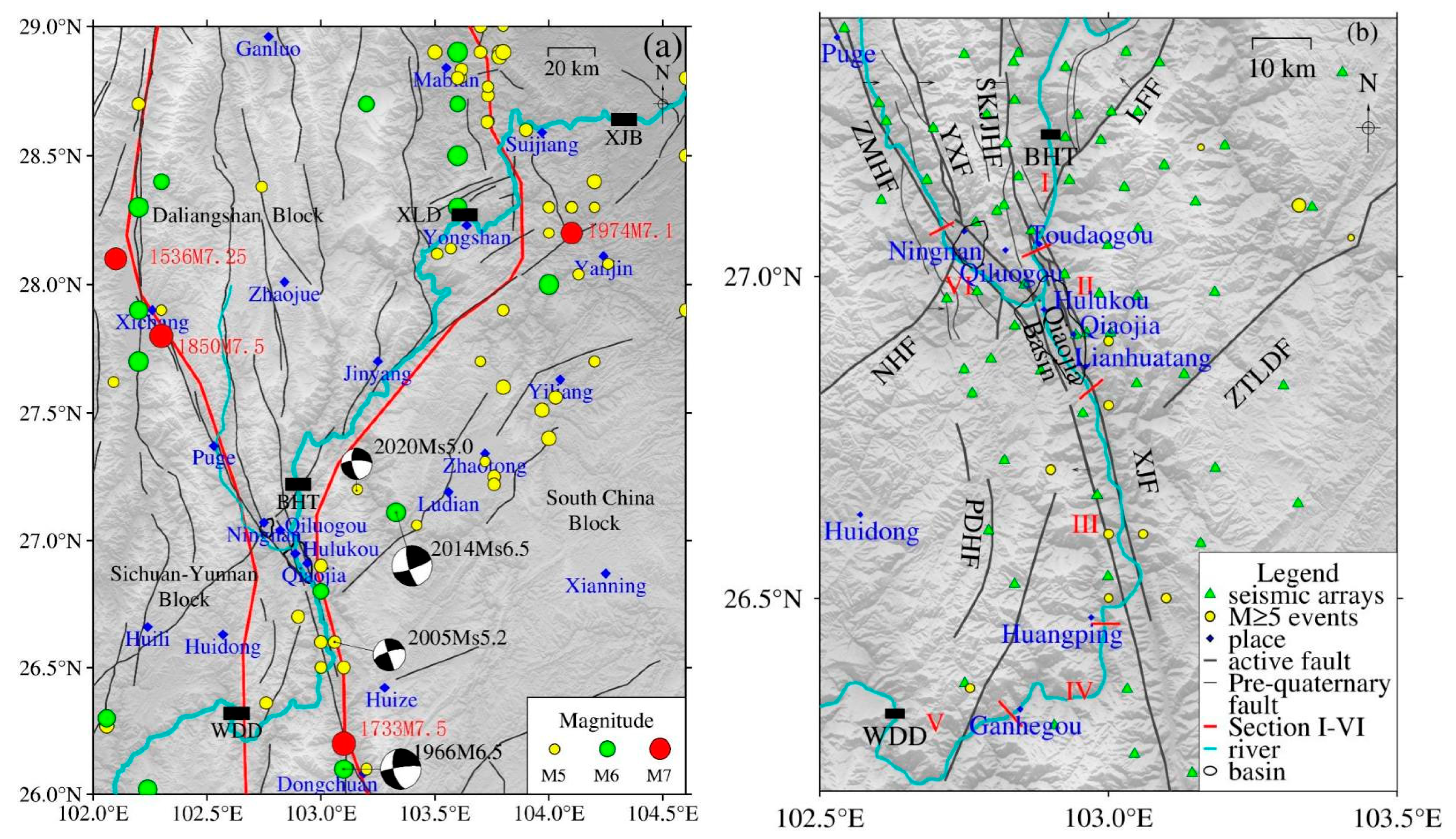



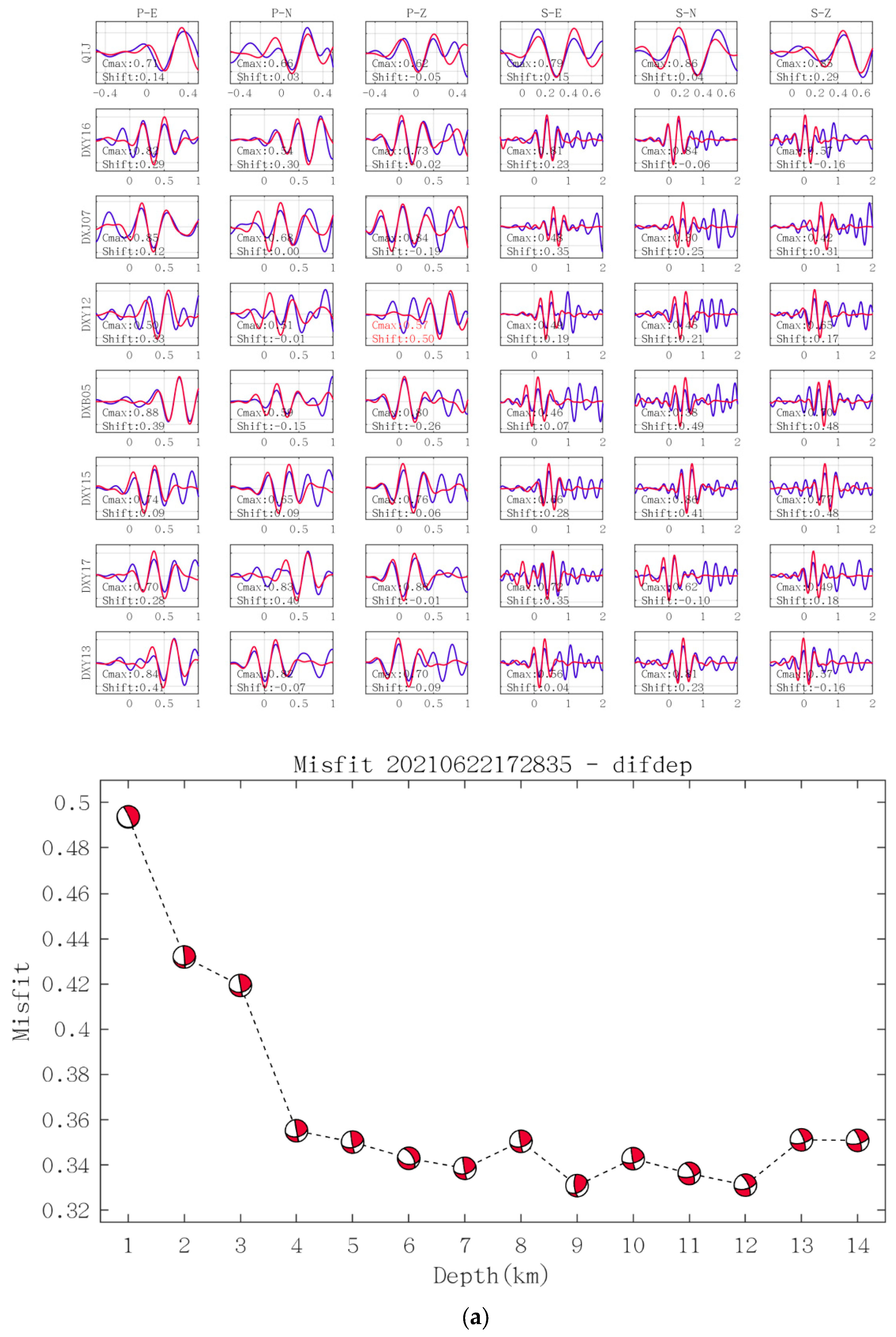
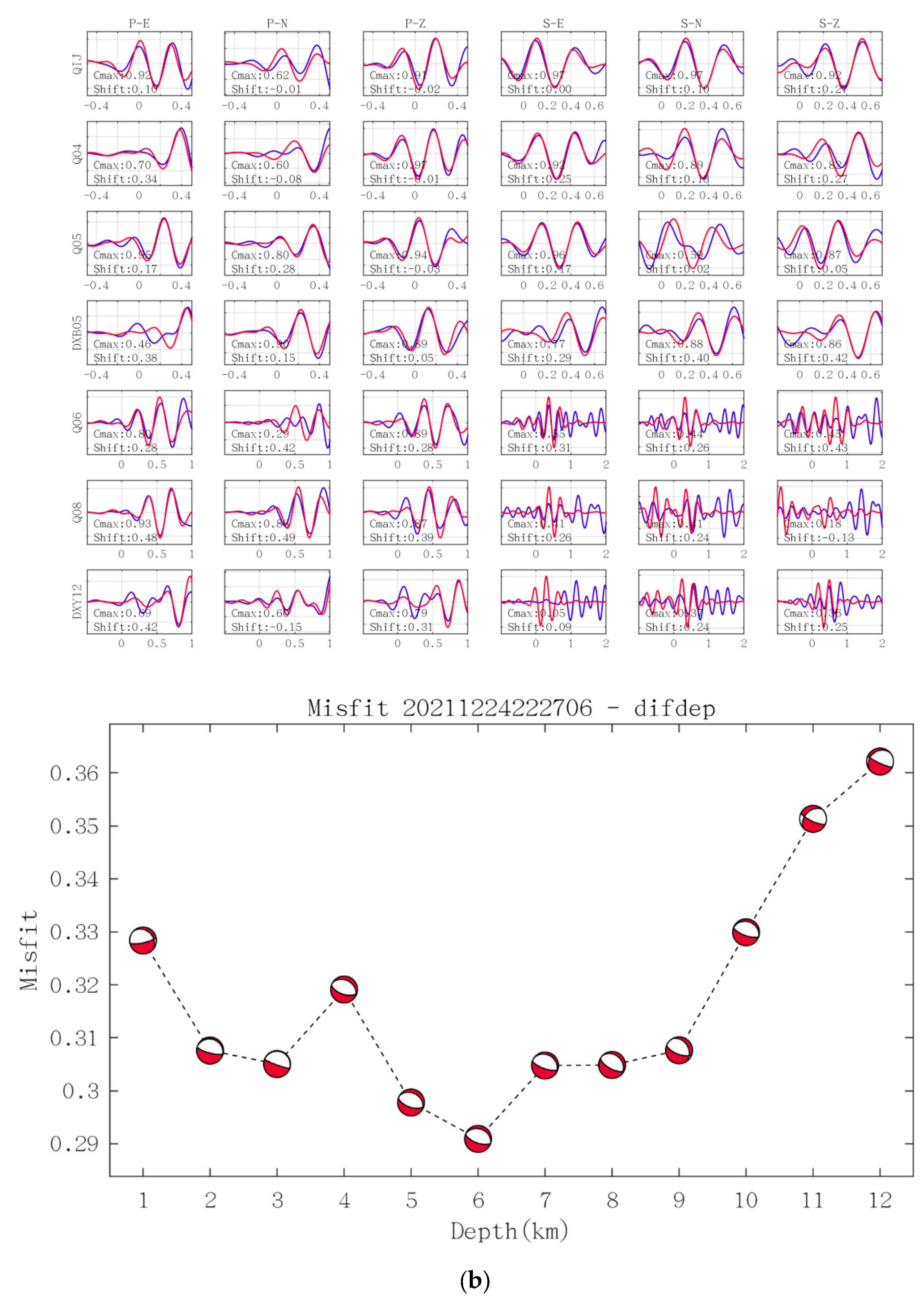

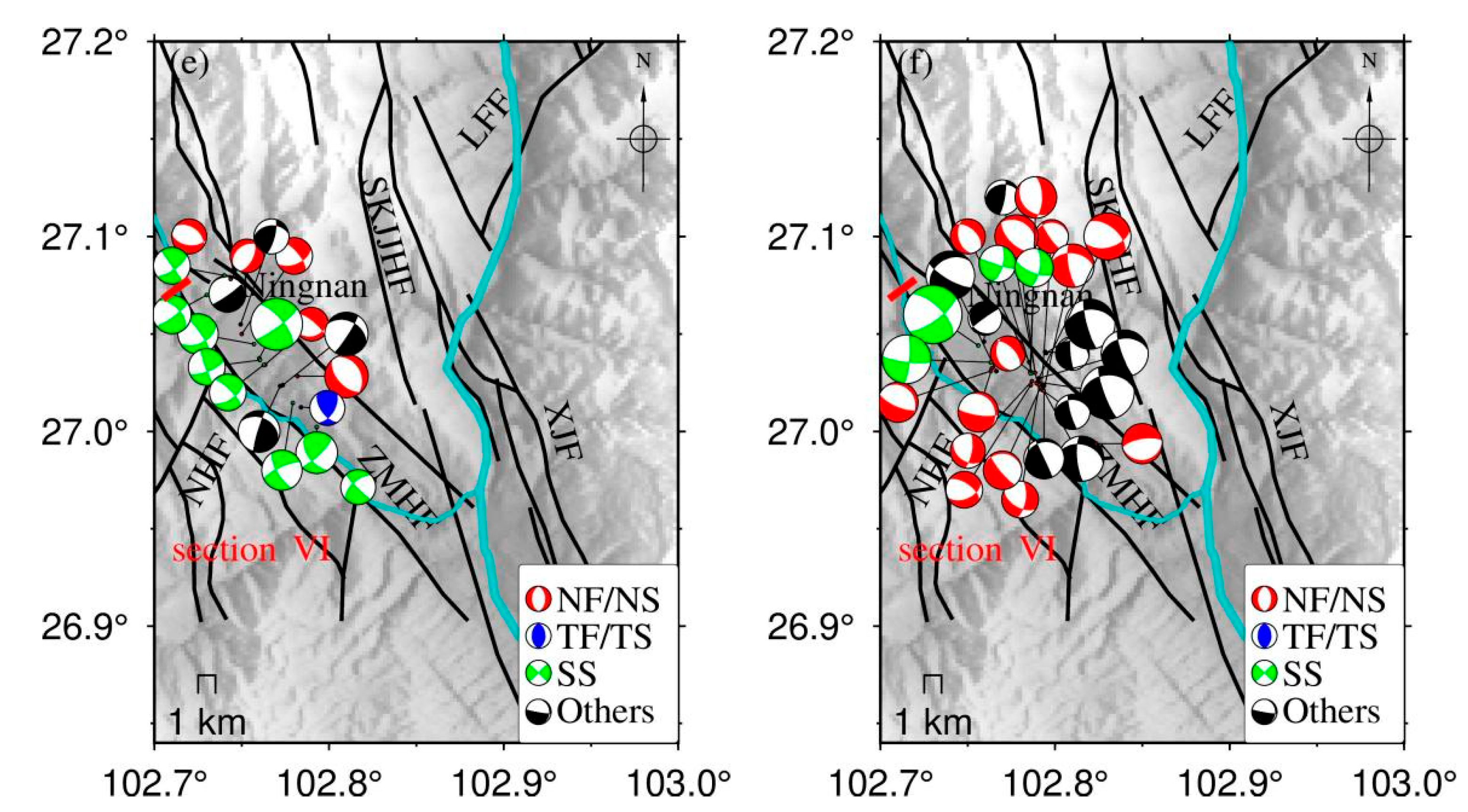

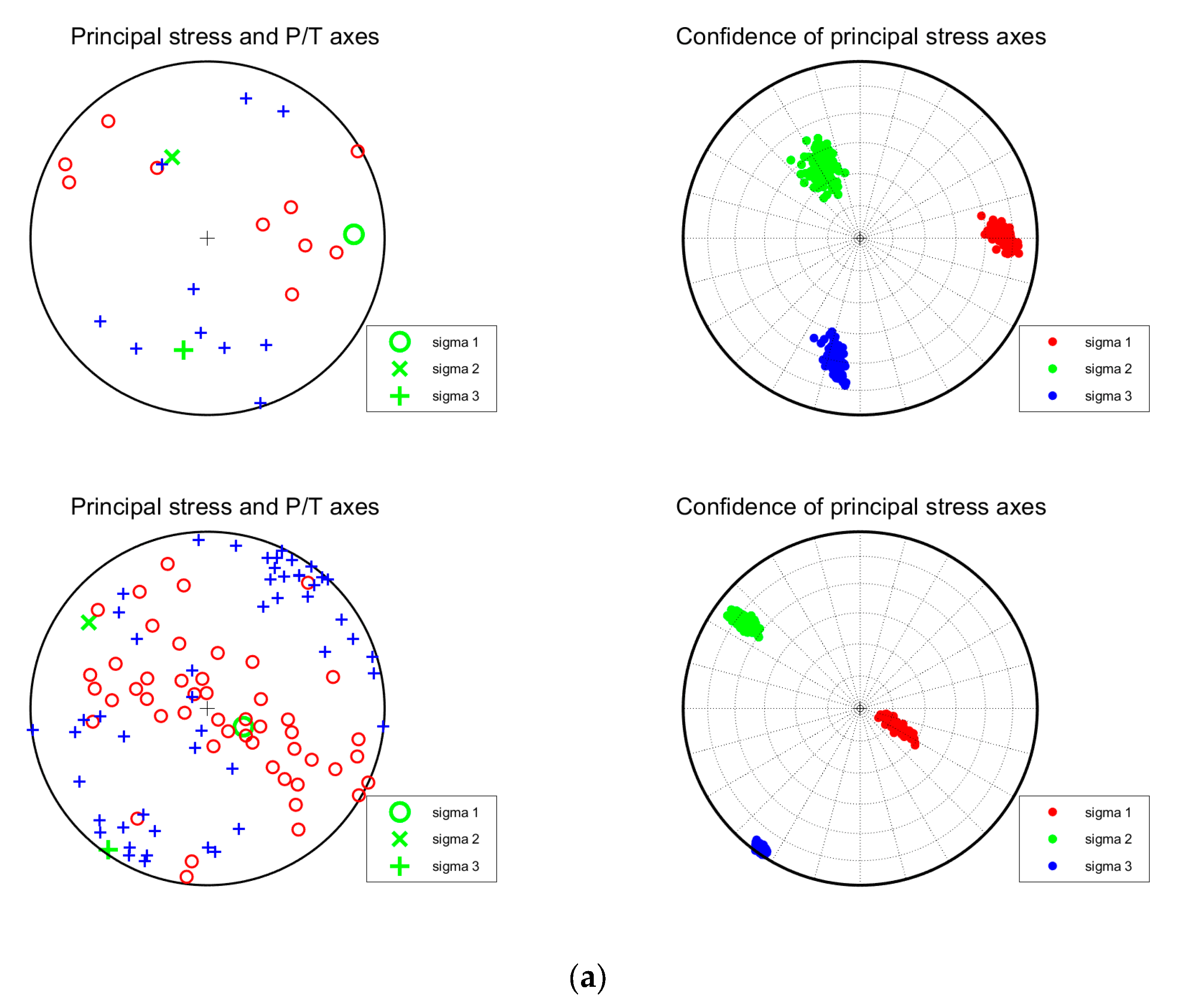

| Type | Plunge of P-Axis σP/° | Plunge of B-Axis σB/° | Plunge of T-Axis σT/° |
|---|---|---|---|
| Normal fault | ≥52 | ≤35 | |
| Normal-strike-slip | 40 ≤ σP < 52 | ≤20 | |
| Strike-slip | <40 | ≥45 | ≤20 |
| Thrust-strike-slip | ≤20 | 40 ≤ σT < 52 | |
| Thrust fault | ≤35 | ≥52 | |
| Others | 20 < σP, σB, σT < 45 or 40 ≤ σP, σT ≤ 50 | ||
| Seismic Event | Index | Strike/° | Dip/° | Rake/° |
|---|---|---|---|---|
| 2021.06.22 ML 2.2 | Optimal solution | 175 | 70 | 55 |
| Mean value | 173 | 79 | 42 | |
| Standard deviation | 5 | 7 | 10 | |
| 2021.12.24 ML 3.7 | Optimal solution | 290 | 25 | −90 |
| Mean value | 308 | 28 | −74 | |
| Standard deviation | 13 | 4 | 11 |
| Stress Field | σ1(/°) | σ2(/°) | σ3(/°) | R | N | ||||
|---|---|---|---|---|---|---|---|---|---|
| Section | Azimuth | Dip | Azimuth | Dip | Azimuth | Dip | |||
| I | Before impoundment | 88.5 | 18.4 | 336.3 | 48.6 | 192.2 | 35.5 | 0.58 | 8 |
| After impoundment | 116.9 | 71.5 | 305.9 | 18.3 | 215.0 | 2.7 | 0.26 | 35 | |
| II | Before impoundment | 262.0 | 62.8 | 128.5 | 19.5 | 31.8 | 18.2 | 0.60 | 48 |
| After impoundment | 306.4 | 49.8 | 124.2 | 40.2 | 215.1 | 1.1 | 0.55 | 69 | |
| VI | Before impoundment | 287.0 | 29.9 | 114.6 | 59.9 | 18.9 | 3.3 | 0.66 | 19 |
| After impoundment | 84.5 | 78.4 | 307.5 | 8.5 | 216.3 | 7.8 | 0.55 | 28 | |
Disclaimer/Publisher’s Note: The statements, opinions and data contained in all publications are solely those of the individual author(s) and contributor(s) and not of MDPI and/or the editor(s). MDPI and/or the editor(s) disclaim responsibility for any injury to people or property resulting from any ideas, methods, instructions or products referred to in the content. |
© 2023 by the authors. Licensee MDPI, Basel, Switzerland. This article is an open access article distributed under the terms and conditions of the Creative Commons Attribution (CC BY) license (https://creativecommons.org/licenses/by/4.0/).
Share and Cite
Guo, W.; Zhao, C. Focal Mechanisms and Stress Field Characteristics of Microearthquakes in Baihetan Reservoir in the Downstream Area of Jinsha River. Water 2023, 15, 709. https://doi.org/10.3390/w15040709
Guo W, Zhao C. Focal Mechanisms and Stress Field Characteristics of Microearthquakes in Baihetan Reservoir in the Downstream Area of Jinsha River. Water. 2023; 15(4):709. https://doi.org/10.3390/w15040709
Chicago/Turabian StyleGuo, Wei, and Cuiping Zhao. 2023. "Focal Mechanisms and Stress Field Characteristics of Microearthquakes in Baihetan Reservoir in the Downstream Area of Jinsha River" Water 15, no. 4: 709. https://doi.org/10.3390/w15040709





